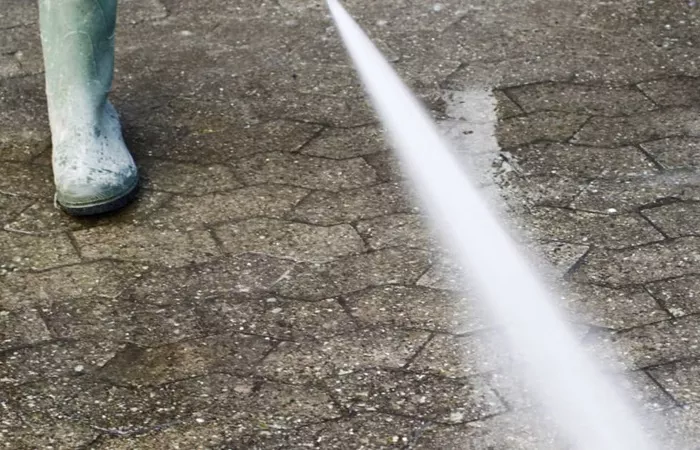If you’ve been wondering how to clean patio pavers without a pressure washer, the arrival of spring is the perfect time to find a solution.
As the weather warms up and people spend more time outdoors, cleaning outdoor spaces becomes a priority for many. Here, our professional cleaners share step-by-step advice on how to get your patio ready for summer without the need for a powerful spray.
While pressure washers are often touted as a convenient way to clean, many people don’t own one, don’t have the budget or desire to rent one, or worry that they could cause more harm than good to delicate or winter-worn surfaces when it comes to necessary outdoor cleaning in the spring.
How to Clean Patio Pavers Without a Pressure Washer
Step 1: Prepare the Space
This basic outdoor cleaning task may seem a little daunting, but as Rhonda Wilson, a premium lead cleaner at FreshSpace Cleaning, assures, “Cleaning your patio without a pressure washer will definitely feel like a workout, but at least it’s still doable!”
First, she advises, give your patio a thorough clean by moving all pots, outdoor furniture, and other backyard clutter out of the way, then sweep the space to remove surface dirt, leaves, and pebbles.
“For your first sweep, it’s best to use a heavy-duty broom, like the Rubbermaid Commercial Products Heavy Duty Corn Broom, available on Amazon, because the fibers are flexible enough to catch lightweight debris and stiff enough to push heavier items, like pebbles, without sending them flying,” she advises, which is definitely a patio cleaning mistake to avoid.
For dried leaves that may have accumulated during the colder months, Rhonda recommends lightly spraying them with water, using a spray bottle, like the Bar5F Plastic Spray Bottle, available on Amazon, to add weight.
“It helps them to clump together so they can be moved as a group, making it easier to collect them all at once,” she explains.
At this stage, we also recommend taking the time to clear away weeds and moss. Some gardening gloves, like the COOLJOB gardening gloves sold on Amazon, will make this easier.
And while you’re removing everything from your patio, it’s also a good idea to clean up your backyard. See if you can throw away, repair, donate or sell the items you clear out, just as if there are things you didn’t use last year, maybe now’s the time to throw them away.
Step 2: Wash and rinse your pavers
Before you start washing your pavers, soak them thoroughly.
“You can get a high-pressure nozzle and focus on cleaning out the crevices and removing the dirt,” Rhonda advises. “If your patio is really dirty or muddy, I recommend wearing a raincoat or poncho to prevent the dirt from flying around.”
After soaking, the classic and easiest way to clean is to use warm water mixed with dishwashing liquid, such as Seventh Generation Dishwashing Liquid Free and Clear, available at Walmart, which is all-natural and won’t cause any discoloration, and a stiff-bristle brush.
This step requires a little more effort, but it’s definitely worth an afternoon of cleaning to keep your patio spotless for summer barbecues and outdoor lunches.
For any serious stains, Rhonda adds, “Drop a few drops of Dawn Ultra liquid dishwashing liquid, available at Walmart, onto the surface to remove oil, moss, or any stains. Then scrub with a stiff-bristle brush, available at Amazon.”
In some extreme cases, you may need some strong detergent, especially if your patio has been stained and moldy during the winter.
You can spray a specialty cleaner, such as Wet & Forget Outdoor Concentrated Cleaner, sold at Walmart, onto the pavers using a pump garden sprayer, such as the Chapin Lawn and Garden Pump Pressured Sprayer sold at Amazon, and set it aside.
This cleaner is bleach-free and non-acidic, so it removes mold, moss, and grime without extra scrubbing.
If you don’t want to use any harsh chemicals, you can also try cleaning with vinegar, using Great Value Distilled White Vinegar, available at Walmart.
Simply dilute a 50:50 mix of vinegar and water in a bucket, such as the Sterilite Spout Pail (also available at Walmart), and apply the solution to the pavers with a stiff-bristle brush. Gretchen Boyd, a cleaning expert at a house cleaning company in New York City, says a mixture of white vinegar and water works great on stubborn stains.
So if you’ve tried dish soap and water and some stains just won’t go away, a mixture of white vinegar and water may be the solution, and it’s a great way to clean your home, be economical, and be kind to the planet.
Whichever method you choose, be sure to rinse your patio thoroughly after scrubbing to remove any residue and grime, then allow it to dry thoroughly. So a warm, overcast spring day is ideal for this task, as the cleaner will dry quickly but won’t leave behind traces of soap.
Karina Toner, cleaning expert and operations manager at Spekless, adds, “Once dry, check for any remaining stains. If there are still stubborn stains, repeat the cleaning process or use a specialty paving slab stain remover to remove deep-set stains like algae or mold.”
Step 3: Add a sealer
Finally, once dry, Rhonda recommends spraying an herbicide, such as Compare-N-Save Herbicide, available on Amazon, on the pavers and in the cracks between them to kill any hidden weed roots.
Then, Gretchen adds, apply a protective sealant to the deck. This will give the deck a glossy finish, protect it from future staining and weathering, and keep it looking its best.
“If you want a richer color, go for a wet finish, or a matte finish if you want a more natural look,” says Rhonda.
Related topics:
- Best Overall Shark Detect Pro Robot Vacuum
- Best Multi-Function Roborock Robot Vacuum Cleaner Dyad Pro
- Best Cordless Ryobi Cordless Wet and Dry Vacuum

